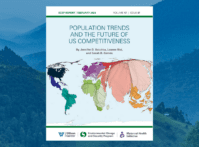-
A Kingdom’s Future: Saudi Arabia Through the Eyes of Its Twentysomethings
January 25, 2013 By Schuyler NullIn a new book from the Wilson Center, Caryle Murphy asks how, while its neighbors face revolutions, Saudi Arabia has been able to “weather the storm of Arab youth discontent seemingly unscathed.”
To find out, Murphy went to the source, interviewing 83 young Saudis between the ages of 19 and 29 in the spring of 2012. She found that “they are by no means a revolutionary lot, preferring gradual, step-by-step change. They want change, but not at the cost of safety and security. Most favor more tolerance for diversity, including in the realm of religion.”
Richard Cincotta on political demography and unrest in the Middle East “Change is coming to the kingdom, and its young people will be – indeed they already are – the crucible of that transformation,” she writes.
Although most of the book is digging deeper into the attitudes and perceptions of young Saudis, Murphy opens with a demographic portrait of the country which draws heavily on ECSP consultant Richard Cincotta’s work on political demography and the relationship between age structure and democracy.
Sixty-four percent of the country is under the age of 30, Murphy explains, and, as Cincotta’s research suggests, populations with large proportions of young people can actually be a hindrance to democratic reforms:
The kingdom’s youthful demographic profile for the next 15 years will also be a factor in political developments. At some point during this time, Saudi Arabia will experience a major transition to a new generation of throne contenders. Since the kingdom’s founding in 1932, the monarch has been selected from among the sons born to its founder, King Abdulaziz bin Saud.
But as that generation dies – King Abdullah bin Abdulaziz is believed to be between 89 and 91 – the monarch will have to come from the second generation of princes, the founder’s grandsons. This transitional period from one generation to the other is fraught with possibilities of royal-family infighting and factionalizing that, under worst-case scenarios, could result in political instability or paralysis.
Whether contentious or placid, this generational transfer will play out against the continued unfolding of momentous events set off by the region’s Arab Awakening. Just as significant, the royal transition will also occur against a backdrop of increasing political consciousness at home. Given current trends among Saudi youth, future twentysomethings will be well educated, globally connected, and politically conscious.
In recent years, some political demographers have looked at what happens to governing systems when large youth bulges mature and a nation’s population becomes less youthful.
Demographer Richard P. Cincotta at the Stimson Center examined these connections and developed a statistical model that links political liberalization to the maturing of a country’s youth population. He found that when a nation’s population reaches the median age of 25, chances begin increasing that its political system will begin to liberalize and even become democratic. By a median age of just under 30 years, those chances become 50/50. His findings were reached by comparing the population-age structure of countries with their political-freedom rankings as determined by Freedom House. For “the past four decades,” Cincotta wrote, “Freedom House has assessed about half of all countries in the 25-to-35-year median age range as ‘free.’”
He argues that his model can predict with relative reliability when a nation is likely to become – and remain – a liberal democracy. In an interview, he explained that the model rests on two pillars. One is the finding, widely accepted in the demographic community, that very youthful populations – where the median age is 25 or below – generally have greater risk of experiencing violence, be it civil conflict, political insurgencies, gang activity or ordinary crime.
As a result, the general population appears willing to accept a loss of some of its political and civil liberties to a non-democratic regime if it provides them with security against this violence.
Download the full publication from the Wilson Center’s Middle East Program.
Topics: demography, From the Wilson Center, gender, livelihoods, Middle East, population, Saudi Arabia, security, youth
 A Publication of the Stimson Center.
A Publication of the Stimson Center.






